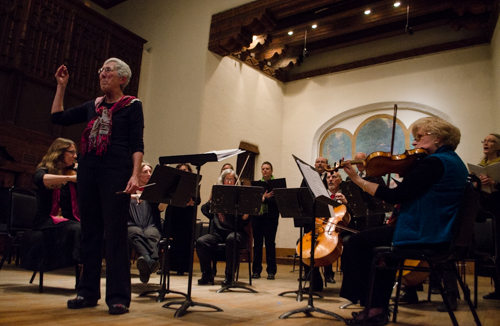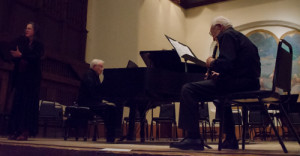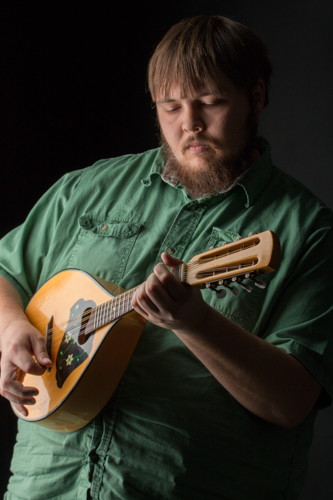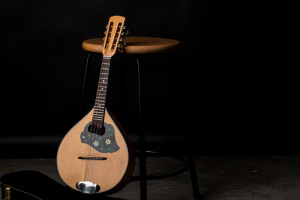Tags
Related Posts
Share This
Happy Bday Bach

Mary Badarak and Santa Fe Music Works lead in singing Happy Birthday to Bach. Photo by Ashley Costello
Musicians gather for sound checks at St. Francis auditorium. They are preparing for the day’s concert in honor of Johann Sebastian Bach’s 330th birthday, and come from all backgrounds: amateurs, students and professionals. SFUAD Contemporary Music Program major John Church sits stage left with a shotgun mic aimed at his mandolin. Over spring break, Church said he was pretty nervous about the upcoming performance. “As time goes on it dwindles, but it might start back up again.”
Two men roll a grand piano across the wooden stage. Scattered spectators populate the auditorium’s creaky pews. The pianist takes his seat and warms up for his performance of Kreuz und krone from Bach Cantata No. 12. Fitzhugh de Gogorza Cline stands in front of the piano, practicing her vocals for the Aria. World class oboist Gerald Fried rounds out the trio. Fried is most well known for composing the scores for the original Star Trek episode, “Amok Time,” the television mini-series Roots and several of Stanley Kubrick’s films.
Church expected to see him at the March 21 performance, but was unsure of who would be joining Fried on his piece. “He’ll probably be accompanied on the piano by [SFUAD Contemporary Music Program instructor] Deborah Ungar or someone else,” Church says. That someone else turns out to be Oscar-winning film composer and jazz pianist Dave Grusin. It’s enough to make any budding musician nervous.
Cline walks down a set of wooden stairs adjacent to the stage. The hem of her black dress flutters around her boots. Church hammers out the Prelude to Bach’s Cello Suite No. 1 in G Major. “Who would’ve thought?” Cline says.
“What’s that?” Church asks.
“Who would’ve thought that Bach would sound so good on the mandolin?”
“Oh, thank you. Your voice sounds wonderful as well.”
“I’m having a little shattering,” she says, “but I think it’s just getting used to the space.”
The space was built in 1917. It looks like a church, but it’s not. It functions as a secular civic center. The walls look like adobe, but they’re not. They are made from plaster and stucco. St. Francis auditorium, along with the New Mexico Museum of Art, was built shortly after New Mexico gained its statehood. It was created in the style of Pueblo Revival architecture or what was known at the time as “New-Old Santa Fe Architecture.” The aesthetic uses irregular cubic forms and an earth-tone palette. Architect Jesse Nusbaum designed the building with the intention of connecting with the region’s social roots. Aspen trees from California make up the roof beams. The woodwork, along with the stucco walls, contribute to the auditorium’s acoustics.
“How’s it sound?” Grusin asks the growing audience. They respond with praise. Church finishes his sound check and sits down in the front pew. The hand-written music staves of Johann Sebastian Bach splatter Church’s tie. A T-shirt image bleeds through the thin material of his button-down shirt, a black square beneath the white fabric. Later in the day, the T-shirt is revealed. The phrase, “I’ll Be Bach” graces an image of the composer wearing sunglasses.
A bassoonist approaches Church. “How long is your piece?” he asks.
“I’m not doing the whole suite, so it should be about 12 minutes.”
“Good, that should be plenty of time for me to get my reeds ready.”
Church spent the last month practicing for the event. He’s had plenty of time to determine the length of his performance. He had already learned the Prelude to the piece before a friend tagged him on Facebook, encouraging him to sign up for the concert. “The event gave me an excuse to buckle down and learn the other movements,” he says.
Oliver Prezant approaches the stage and welcomes the audience. “Thank you all for coming to what we hope will be an annual event. Today would have been the 330th birthday of Johann Sebastian Bach. He wrote his music near the end of the Baroque period. Some people think it was all downhill after Bach, but that’s just an opinion.”
Prezant is the music director of the Santa Fe Community Orchestra. He also teaches Western Music Survey at SFUAD, the class in which Church cultivated his interest in Bach. “I heard the harpsichord solo to the first movement of the Brandenburg Concerto and I was blown away. I played it for a friend of mine who doesn’t even like classical music and he said it sounded like heavy metal. I think it just goes to show how universal his music is. There’s something in its DNA that allows it to transfer to different instruments.”
Grusin, Fried, and Cline take to the stage for the first performace. Cline introduces the cantata. “Bach wrote Cantata No. 12 in 1714.” When she says, “Bach,” she hits the “ch” hard. “The piece was performed for the first time at the Schlosskirche palace in Weimar, Germany.” Cline’s German pronunciation is flawless.
Fried warms up on the oboe, then Grusin strikes the keys to begin. The oboe cries as the piano marches through the introduction. Cline holds her music out in front of her. She opens her mouth to hit the first note and her voice cracks. She places a hand to her chest. Fried hunches over his instrument. It dips between his knees and his body wiggles as he plays. The piece comes to its conclusion with a sour note from Fried. Only Grusin’s performance lacks any noticeable errors.
Prezant introduces the next musician. “John Church will be playing a cello suite, adapted for the mandolin.”
Church takes his seat on stage and places his mandolin in his lap. Two small flowers embellish the instrument’s black guard plate. “I want to dedicate this piece to my grandfather who passed away. He was a huge fan of classical music. We weren’t very close, but I learned a lot about him by listening to the music he loved. He also liked P.D.Q. Bach, but that’s different.”
Church’s joke draws laughter from the crowd, the perfect device to break his nervous energy. He begins the Prelude. The mandolin produces a gentle timber. Church leans his head to one side as he plays, rocking with the rhythm of the
music. He hammers hard on the strings during the second movement. The slightest motion in his peripheral vision causes him to look up from time to time, but he continues playing without hesitation. The climax of his performance is the swift Courante, which is light and playful. His fingers dance over the fingerboard. He plucks the last few notes in an increasing retard. The audience applauds. Church steps off the stage with a slight shake of his head. He sits down in the pew next to Cline. “That was great,” she says.
Church is followed by a wind ensemble that includes Fried on the oboe, Michael Golden on clarinet and James Preus and Richard Hall on the bassoons. They perform Piano Toccata in C Minor, transcribed by Leonard Tischler. The
bassoons are massive instruments, almost as tall as the musicians who haul them on stage. Tiny mouthpieces snake out of the ends like the curving heads of swans. Fried gets ahead of the other performers at times, forcing them to catch up with him.
The final act consists of the largest number of musicians. Mary Badarak conducts a string ensemble and chorus in Cantata No. 4. The piece chronicles the discovery of Jesus’ absence from his tomb and the subsequent revelation of the angel that Christ has risen. “It ends with many, many, many ‘alleluias,’” says Badarak, “so feel free to get up and dance.
The cantata is proceeded by the “Happy Birthday” song for Bach and the audience joins in with the singing. The group then concludes the day’s celebration with Cantata No. 140, one of Bach’s most recognizable works. The true title of the piece is Wachet Auf ruft uns die Stimme, which translates to “Awake, the voice is calling us,” or, as Badarak puts it, “Y’all wake up.”
All of the string performers set aside their instruments, except for cellist Michael Brinegar, who plucks his strings instead of using his bow. From the first note it is clear that this is not the normal arrangement. The basses and tenors echo the notes of the cello. The altos sing the traditional violin parts while the sopranos sing the words. One of the violinists sits by Brinegar, tapping her finger to the beat. Badarak sings along with the chorus. As the piece comes to a close, the audience applauds and a violinist stomps her foot.
Prezant approaches the front of the stage to make his closing comments. “Now you can tell your grandchildren that you were at the very first Bach Birthday Bash.”
Wooden seats moan as the crowd rises to exit the auditorium. When asked about the shaking of his head at the end of his performance, Church replies, “I messed up in a few places.”
Whatever mistakes Church may have made, they were imperceptible to the non-musicians and amateur musicians in the audience. Church may have entered in the student category, but his performance was on par with the professionals. It is a testament to the skill of the performers and the legacy of Johann Sebastian Bach that when the audience walked out onto Palace Avenue, many were humming a tune that was written more than three centuries ago.









 Jackalope Magazine is the student magazine of Santa Fe University of Art and Design. Building on the interdisciplinary nature of our education, we aim to showcase the talent of our university and character of our city.
Jackalope Magazine is the student magazine of Santa Fe University of Art and Design. Building on the interdisciplinary nature of our education, we aim to showcase the talent of our university and character of our city.
Recent Comments